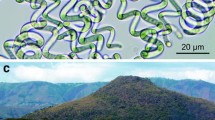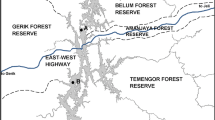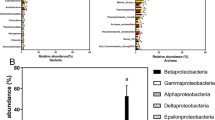Abstract
Members of the phylum Planctomycetes were originally described as freshwater bacteria. Most recent studies, however, address planctomycete diversity in other environments colonized by these microorganisms, including marine and terrestrial ecosystems. This study was initiated in order to revisit the specific patterns of planctomycete diversity in freshwater habitats using cultivation-independent approaches. The specific focus was made on planctomycetes associated with Nuphar lutea (L.) Smith, an emergent macrophyte with floating leaves, which is widespread in the Holarctic. As revealed by Illumina pair-end sequencing of 16S rRNA gene fragments, the bacterial assemblages colonizing floating leaf blades of waterlilies sampled from two different boreal lakes displayed similar composition but were distinct from the planktonic bacterial communities. 16S rRNA gene fragments from the Planctomycetes comprised 0.1–1 and 1–2.2% of total 16S rRNA gene reads retrieved from water samples and plant leaves, respectively. Planktonic planctomycetes were mostly affiliated with the class Planctomycetaceae (77–97%), while members of the Phycisphaerae were less abundant (3–22%). The relative proportion of the latter group, however, increased by 13–45% on leaves of N. lutea. The Phycisphaera-related group WD2101, Pirellula-like planctomycetes, as well as Gemmata, Zavarzinella and Planctopirus species were the most abundant groups of planctomycetes associated with plant leaves, which may suggest their involvement in the degradation of plant-derived organic matter.





Similar content being viewed by others
References
Bauld J, Staley JT (1976) Planctomyces maris sp. nov.: a marine isolate of the Planctomyces-Blastocaulis group of budding bacteria. Microbiology 97:45–55. https://doi.org/10.1099/00221287-97-1-45
Belova M (1993) Microbial decomposition of freshwater macrophytes in the littoral zone of lakes. Hydrobiologia 251:59–64. https://doi.org/10.1007/BF00007165
Bengtsson MM, Sjøtun K, Øvreås L (2010) Seasonal dynamics of bacterial biofilms on the kelp Laminaria hyperborea. Aquat Microb Ecol 60:71–83. https://doi.org/10.3354/ame01409
Bondoso J, Balague V, Gasol JM, Lage OM (2014) Community composition of the Planctomycetes associated with different macroalgae. FEMS Microbiol Ecol 88:445–456. https://doi.org/10.1111/1574-6941.12258
Bondoso J, Godoy-vitorino F, Gasol JM et al (2017) Epiphytic Planctomycetes communities associated with three main groups of macroalgae. FEMS Microbiol Ecol. https://doi.org/10.1093/femsec/fiw255
Brock TCM, De Lyon MJH, Van Laar EMJM, Van Loon EMM (1985) Field studies on the breakdown of Nuphar lutea (L.)SM. (Nymphaeaceae), and a comparison of three mathematical models for organic weight loss. Aquat Bot 21:1–22. https://doi.org/10.1016/0304-3770(85)90091-9
Brümmer IHM, Felske ADM, Wagner-Döbler I (2004) Diversity and seasonal changes of uncultured Planctomycetales in river biofilms. Appl Environ Microbiol 70:5094–5101. https://doi.org/10.1128/AEM.70.9.5094-5101.2004
Burke C, Thomas T, Lewis M et al (2010) Composition, uniqueness and variability of the epiphytic bacterial community of the green alga Ulva australis. ISME J 5:590–600. https://doi.org/10.1038/ismej.2010.164
Caporaso J, Kuczynski J, Stombaugh J (2010a) QIIME allows analysis of high-throughput community sequencing data. Nat Methods 7:335–336. https://doi.org/10.1038/nmeth0510-335
Caporaso JG, Lauber CL, Walters WA et al (2010b) Global patterns of 16S rRNA diversity at a depth of millions of sequences per sample. Proc Natl Acad Sci USA 108:4516–4522. https://doi.org/10.1073/pnas.1000080107/-/DCSupplemental.www.pnas.org/cgi/doi/10.1073/pnas.1000080107
Dedysh SN, Derakshani M, Liesack W (2001) Detection and enumeration of methanotrophs in acidic Sphagnum peat by 16S rRNA fluorescence in situ hybridization, including the use of newly developed oligonucleotide probes for Methylocella palustris. Appl Environ Microbiol 67:4850–4857. https://doi.org/10.1128/AEM.67.10.4850-4857.2001
Donderski W, Kalwasińska A (2002) Epiphytic bacteria inhabiting the Yellow Waterlily (Nuphar luteum L.). Polish J Environ Stud 11:501–507
Easlon HM, Bloom AJ (2014) Easy leaf area: automated digital image analysis for rapid and accurate measurement of leaf area. Appl Plant Sci 2:1400033. https://doi.org/10.3732/apps.1400033
Fouke BW, Bonheyo GT, Sanzenbacher B, Frias-Lopez J (2003) Partitioning of bacterial communities between travertine depositional facies at Mammoth Hot Springs, Yellowstone National Park, U.S.A. Can J Earth Sci 40:1531–1548. https://doi.org/10.1139/e03-067
Franzmann PD, Skerman VB (1984) Gemmata obscuriglobus, a new genus and species of the budding bacteria. Antonie Van Leeuwenhoek 50:261–268. https://doi.org/10.1007/BF02342136
Gimesi N (1924) Hydrobiologiai Tanulmányok [Hydrobiological studies]. I. Planctomyces bekefii Gim. nov. gen. et sp. [Hungarian with German translation]. Budapest Kiadja a Magy Ciszterci Rend 1–8
Giovannoni SJ, Schabtach E, Castenholz RW (1987) Isosphaera pallida, gen. and comb. nov., a gliding, budding eubacterium from hot springs. Arch Microbiol 147:276–284. https://doi.org/10.1007/BF00463488
Glöckner FO, Kube M, Bauer M et al (2003) Complete genome sequence of the marine planctomycete Pirellula sp. strain 1. Proc Natl Acad Sci USA 100:8298–8303. https://doi.org/10.1073/pnas.1431443100
Grabherr MG, Haas BJ, Yassour M et al (2011) Full-length transcriptome assembly from RNA-Seq data without a reference genome. Nat Biotechnol 29:644–652. https://doi.org/10.1038/nbt.1883
Hahn MW (2006) The microbial diversity of inland waters. Curr Opin Biotechnol 17:256–261. https://doi.org/10.1016/j.copbio.2006.05.006
Hirsch P, Müller M (1985) Planctomyces limnophilus sp. nov., a stalked and budding bacterium from freshwater. Syst Appl Microbiol 6:276–280. https://doi.org/10.1016/S0723-2020(85)80031-X
Ivanova AO, Dedysh SN (2012) Abundance, diversity, and depth distribution of Planctomycetes in acidic northern wetlands. Front Microbiol 3:5. https://doi.org/10.3389/fmicb.2012.00005
Ivanova AA, Kulichevskaya IS, Merkel AY et al (2016) High diversity of Planctomycetes in soils of two lichen-dominated sub-arctic ecosystems of northwestern Siberia. Front Microbiol 7:2065. https://doi.org/10.3389/fmicb.2016.02065
Jenkins C, Staley JT (2013) History, classification and cultivation of the Planctomycetes. In: Fuerst JA (ed) Planctomycetes: cell structure, origins and biology. Humana Press, Totowa, pp 1–38
Kim JW, Brawley SH, Prochnik S et al (2016) Genome analysis of Planctomycetes inhabiting blades of the red alga Porphyra umbilicalis. PLoS ONE 11:e0151883. https://doi.org/10.1371/journal.pone.0151883
Klink A (2005) Chemical changes and nutrient release during decomposition processes of mature leaves of Nuphar lutea [L.] Sibith. and Sm under laboratory conditions. Int J Ecohydrol Hydrobiol 5:215–222
Klok PF, van der Velde G (2017) Plant traits and environment: floating leaf blade production and turnover of waterlilies. PeerJ 5:e3212. https://doi.org/10.7717/peerj.3212
Kok CJ, Van der Velde G, Landsbergen KM (1990) Production, nutrient dynamics and initial decomposition of floating leaves of Nymphaea alba L. and Nuphar lutea (L.) Sm. (Nymphaeaceae) in alkaline and acid waters. Biogeochemistry 11:235–250. https://doi.org/10.1007/BF00004498
Kovaleva OL, Merkel AYY, Novikov AA et al (2015) Tepidisphaera mucosa gen.nov., sp.nov., a moderately thermophilic member of the class Phycisphaerae in the phylum Planctomycetes, and proposal of a new family, Tepidisphaeraceae fam.nov., and a new order, Tepidisphaerales. Int J Syst Evol Microbiol 65:549–555. https://doi.org/10.1099/ijs.0.070151-0
Kublanov IV, Perevalova AA, Slobodkina GB et al (2009) Biodiversity of thermophiiic prokaryotes with hydrolytic activities in hot springs of Uzon Caldera, Kamchatka (Russia). Appl Environ Microbiol 75:286–291. https://doi.org/10.1128/AEM.00607-08
Kulichevskaya IS, Belova SE, Komov VT et al (2011) Phylogenetic composition of bacterial communities in small boreal lakes and ombrotrophic bogs of the upper Volga basin. Microbiology 80:549–557. https://doi.org/10.1134/S0026261711040114
Kurashov EA, Fedorova EV, Krylova JV, Mitrukova GG (2016) Assessment of the potential biological activity of low molecular weight metabolites of freshwater macrophytes with QSAR. Scientifica (Cairo) https://doi.org/10.1155/2016/1205680
Lage OM, Bondoso J (2014) Planctomycetes and macroalgae, a striking association. Front Microbiol 5:1–9. https://doi.org/10.3389/fmicb.2014.00267
Lindström ES, Kamst-Van Agterveld MP, Zwart G (2005) Distribution of typical freshwater bacterial groups is associated with pH, temperature, and lake water retention time. Appl Environ Microbiol 71:8201–8206. https://doi.org/10.1128/AEM.71.12.8201-8206.2005
Mazurkiewicz-Zapałowicz K, Golianek A, Łopusiewicz Ł (2016) Microscopic fungi on Nymphaeaceae plants of the Lake Płociczno in Drawa National Park (NW Poland). Acta Mycol 51:1079. https://doi.org/10.5586/am.1079
Mille-Lindblom C, Fischer H, Tranvik LJ (2006) Litter-associated bacteria and fungi—a comparison of biomass and communities across lakes and plant species. Freshw Biol 51:730–741. https://doi.org/10.1111/j.1365-2427.2006.01532.x
Miranda LN, Hutchison K, Grossman AR, Brawley SH (2013) Diversity and abundance of the bacterial community of the red macroalga Porphyra umbilicalis: did bacterial farmers produce macroalgae? PLoS ONE. https://doi.org/10.1371/journal.pone.0058269
Morrison JM, Baker KD, Zamor RM et al (2017) Spatiotemporal analysis of microbial community dynamics during seasonal stratification events in a freshwater lake (Grand Lake, OK, USA). PLoS ONE 12:e0177488. https://doi.org/10.1371/journal.pone.0177488
Neef A, Amann R, Schlesner H, Schleifer K-H (1998) Monitoring a widespread bacterial group: in situ detection of Planctomycetes with 16S rRNA-targeted probes. Microbiology 144:3257–3266
Ntougias S, Polkowska Ż, Nikolaki S et al (2016) Bacterial community structures in freshwater polar environments of Svalbard. Microbes Env 31:401–409. https://doi.org/10.1264/jsme2.ME16074
Okazaki Y, Fujinaga S, Tanaka A et al (2017) Ubiquity and quantitative significance of bacterioplankton lineages inhabiting the oxygenated hypolimnion of deep freshwater lakes. ISME J 11:2279–2293. https://doi.org/10.1038/ismej.2017.89
Pollet T, Tadonléké RD, Humbert J-F (2011a) Comparison of primer sets for the study of Planctomycetes communities in lentic freshwater ecosystems. Environ Microbiol Rep 3:254–261. https://doi.org/10.1111/j.1758-2229.2010.00219.x
Pollet T, Tadonléké RD, Humbert JF (2011b) Spatiotemporal changes in the structure and composition of a less-abundant bacterial phylum (Planctomycetes) in two perialpine lakes. Appl Environ Microbiol 77:4811–4821. https://doi.org/10.1128/AEM.02697-10
Pruesse E, Quast C, Knittel K et al (2007) SILVA: a comprehensive online resource for quality checked and aligned ribosomal RNA sequence data compatible with ARB. Nucleic Acids Res 35:7188–7196. https://doi.org/10.1093/nar/gkm864
Quast C, Pruesse E, Yilmaz P et al (2013) The SILVA ribosomal RNA gene database project: improved data processing and web-based tools. Nucleic Acids Res 41:D590–D596. https://doi.org/10.1093/nar/gks1219
Scheuner C, Tindall BJ, Lu M, et al (2014) Complete genome sequence of Planctomyces brasiliensis type strain (DSM 5305T), phylogenomic analysis and reclassification of Planctomycetes including the descriptions of Gimesia gen. nov., Planctopirus gen. nov. and Rubinisphaera gen. nov. and emended des. Stand Genomic Sci 9:10. https://doi.org/10.1186/1944-3277-9-10
Staley JT (1973) Budding bacteria of the Pasteuria – Blastobacter group. Can J Microbiol 19:609–614. https://doi.org/10.1139/m73-100
Thomas F, Hehemann JH, Rebuffet E et al (2011) Environmental and gut Bacteroidetes: the food connection. Front Microbiol 2:93. https://doi.org/10.3389/fmicb.2011.00093
Urbach E, Vergin KL, Young L et al (2001) Unusual bacterioplankton community structure in ultra-oligotrophic Crater Lake. Limnol Oceanogr 46:557–572. https://doi.org/10.4319/lo.2001.46.3.0557
van Kessel MA, Dutilh BE, Neveling K, et al (2011) Pyrosequencing of 16S rRNA gene amplicons to study the microbiota in the gastrointestinal tract of carp (Cyprinus carpio L.). AMB Express 1:41. https://doi.org/10.1186/2191-0855-1-41
Vergeer LHT, Van Der Velde G (1997) Phenolic content of daylight-exposed and shaded floating leaves of water lilies (Nymphaeaceae) in relation to infection by fungi. Oecologia 112:481–484. https://doi.org/10.1007/s004420050335
Vollmers J, Rast P, Jogler C (2017) Untangling genomes of novel Planctomycetal and Verrucomicrobial species from Monterey Bay kelp forest metagenomes by refined binning. Front Microbiol 8:472. https://doi.org/10.3389/fmicb.2017.00472
Wegner CE, Richter-Heitmann T, Klindworth A et al (2013) Expression of sulfatases in Rhodopirellula baltica and the diversity of sulfatases in the genus Rhodopirellula. Mar Genomics 9:51–61. https://doi.org/10.1016/j.margen.2012.12.001
Yang C, Wang Q, Simon PN et al (2017) Distinct network interactions in particle-associated and free-living bacterial communities during a Microcystis aeruginosa bloom in a plateau lake. Front Microbiol 8:1202. https://doi.org/10.3389/fmicb.2017.01202
Żbikowski J, Kobak J, Żbikowska E (2010) Is Nuphar lutea (L.) Sm. a structuring factor for macrozoobenthos and selected abiotic parameters of water and bottom sediments throughout the year? Aquat Ecol 44:709–721. https://doi.org/10.1007/s10452-009-9309-9
Funding
This study was supported by the Russian Foundation for Basic Research (Project No. 16-04-00290) and the Program “Molecular and Cell Biology” of RAS.
Author information
Authors and Affiliations
Corresponding author
Ethics declarations
Conflict of interest
The authors declare that they have no conflict of interest.
Electronic supplementary material
Below is the link to the electronic supplementary material.
10482_2017_986_MOESM1_ESM.pdf
Supplementary Figure S1. The lake Khotavets (A) and the oxbow lake Sjamgena (B). Supplementary Figure S2. Comparison of the microbial community composition in samples examined in this study by principle coordinate analyses (PCoA). PCoA plots are based on the weighted (right panel) and unweighted (left panel) UniFrac distances of the pyrosequencing datasets. Supplementary Figure S3. Venn diagram showing the number of shared and unique OTUs between samples examined in this study. Supplementary material 1 (PDF 556 kb)
Rights and permissions
About this article
Cite this article
Ivanova, A.A., Philippov, D.A., Kulichevskaya, I.S. et al. Distinct diversity patterns of Planctomycetes associated with the freshwater macrophyte Nuphar lutea (L.) Smith. Antonie van Leeuwenhoek 111, 811–823 (2018). https://doi.org/10.1007/s10482-017-0986-4
Received:
Accepted:
Published:
Issue Date:
DOI: https://doi.org/10.1007/s10482-017-0986-4




